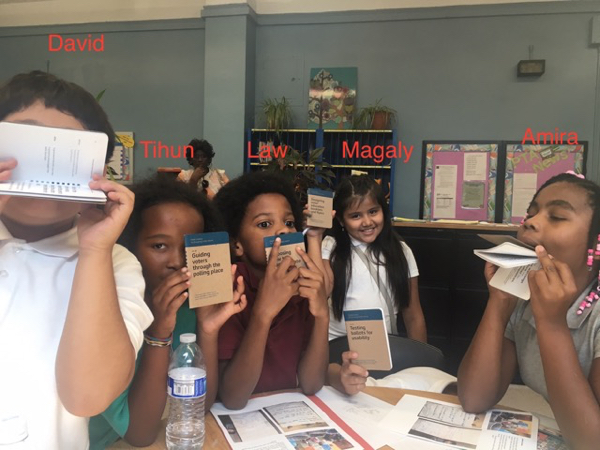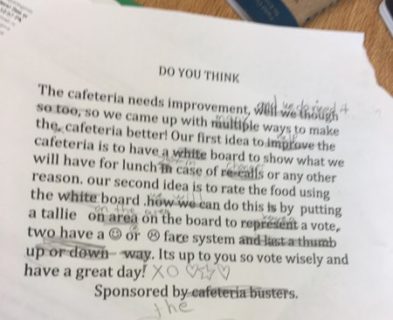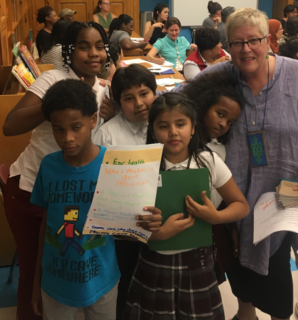Election admin – 4th and 5th grade style
The students at an elementary public school in Brooklyn are holding their own elections.
It’s all part of an innovative civics education program. DK Holland, who is working with the students, says that the goal is to help them develop a sense of determination and become engaged, active participants in civic life (and future voters, of course).
Before we go any further, let’s meet the fourth and fifth graders who are running the election.

David, Tihun, Law, Magaly and Amira are the members of the PS 20 Council which is running the election. And yes, those are Field Guides they are holding.
The first election this year is on ways to improve their cafeteria. They decided on an initiative because many people think that “elections” are only to pick candidates for offices.
Once they decided that the first election would focus on the cafeteria, the students gathered nominations for what improvement projects to take on. Showing how well they understand democracy, they insisted that everyone in the school should have a voice in the process. As David said, “Adult people think they have all the solutions. But kids have solutions, too.”
They are also the election administrators and are creating all of the materials, from making flyers to promote the choices on the ballot, designing the ballot, and building the ballot boxes.

The ballot boxes they created say it all: “We will be seen AND heard” and “We show real courage.”
The candidate projects on the ballot show just how grown up fourth and fifth graders can be when they are taken seriously. In their discussions, they focused on real improvements for everyone (and the environment). They will be voting on solutions to problems they identified like:
- Make the cafeteria workers’ jobs easier (because they noticed that they always seem a little harried).
- Keep the cafeteria tables cleaner (because they see how much trash is left behind).
- Do better at recycling (because trash gets dumped into the recycling bins willy nilly because the signage is confusing).
- Be more informed (because the Department of Education is responsible for feeding 1.1 million kids a day. Sometimes there is a SNAFU, like a recall. The kids understand this but why want to know what they are going to be fed).
The team read the Field Guides, and liked them enough that they all wanted their own, even if some of the vocabulary was challenging for them.

Art materials, Field Guides, and pre-tween energy fuel the election design process.
This election is just a warm up. For the next one, at the end of October, they want to have their own presidential election. Instead of voting on the candidates, they are going to vote on what qualities they want to see in a President. They think that’s even better, because as David put it, “anyone who wants to be President – including me – will hear this.”
Their first ideas about what makes a good president:
“Someone who listens to people and sees the problems in the world and tries to fix things.” (David)
“People can try to solve problems but only make them worse. A good president would not do that.” (Magaly)
“Someone who recognizes the rights of others.” (Law)
We can’t wait to hear how the elections turn out. As Amira put it, “Being heard is a human right and a child is a human, right?”

Tihun shows us the goal: having a voice.
Update – October 26
The Kids’ Council work continues as the grapple with everything from the big issues of democracy to the mechanics of running the election.
But first, the students say, you have to understand an issue before you can vote on it – and that includes learning about it themselves as well as creating ways to educate the other students.
They are continuing to research how the cafeteria works. They want to know about the impact of recycling and how it works, so they are doing research on where trash goes and sources of pollution. The science teacher created a class unit on the ecology of the cafeteria.
To run an election on a project, you have to describe the project so the group is working on the statement to go on the ballot for the first initiative: a notice board to tell the students what’s for lunch that day and let them rate the meals.

David wrote the first draft for the ballot.
They all discussed it while Amira edited.
With all this work to do, they decided to hold the cafeteria initiatives until after the presidential vote, which they will hold around November 8.
They aren’t going to vote on candidates, but on which are the most important characteristics for an elected leader to have and not to have. The ballot will have 6 good and 6 bad traits, drawn from what they are hearing in this year’s campaigns. Students will vote on which are the best and worst.
As they work through the mechanics of voting, they want to make sure that voting is fair. They talked about how no one should have more than one vote, even the principal. “That wouldn’t be fair.” David said. Tihun suggested they should check off voters on a list of the students so that no one votes more than once.
They are also learning how to be advocates for their work. They each wrote their own part of a presentation to a packed PTA meeting on the theme “Children are to be seen AND heard.”

The Kids’ Council and DK Holland after a successful presentation at the PTA
The group defined politicians as “people who can help change the world.” It took a moment for them to recognize that they are now part of that definition.
Next up: designing the ballot and holding the election. We’ll be back with the results after they count the votes of around 100 students, and analyze the process.
Don’t you wish you could be a fly on the wall when they present their findings for a class discussion?
About the program
Education innovator and TED resident DK Holland has been working with the 3rd-5th grade kids of PS 20 in Brooklyn, NY for over 2 years, creating councils in which students run for office, develop initiatives, discuss and vote on how to improve their learning as well as their school environment.
Inquiring Minds USA is on the 1776 NYC campus, rolling out this strategy. Please contact dk@Inquiringmindsusa.com if you are interested in learning more.
DK took the lovely photos, which are used with permission of the students and their families.
DK also writes about her work at PS 20 on Medium. Her first article “It’s like WWW but without the Nazis” describes how the council decided to focus on the cafeteria.
1 Comment
-
Future voters: Students vote on what makes a good president | Center for civic design

